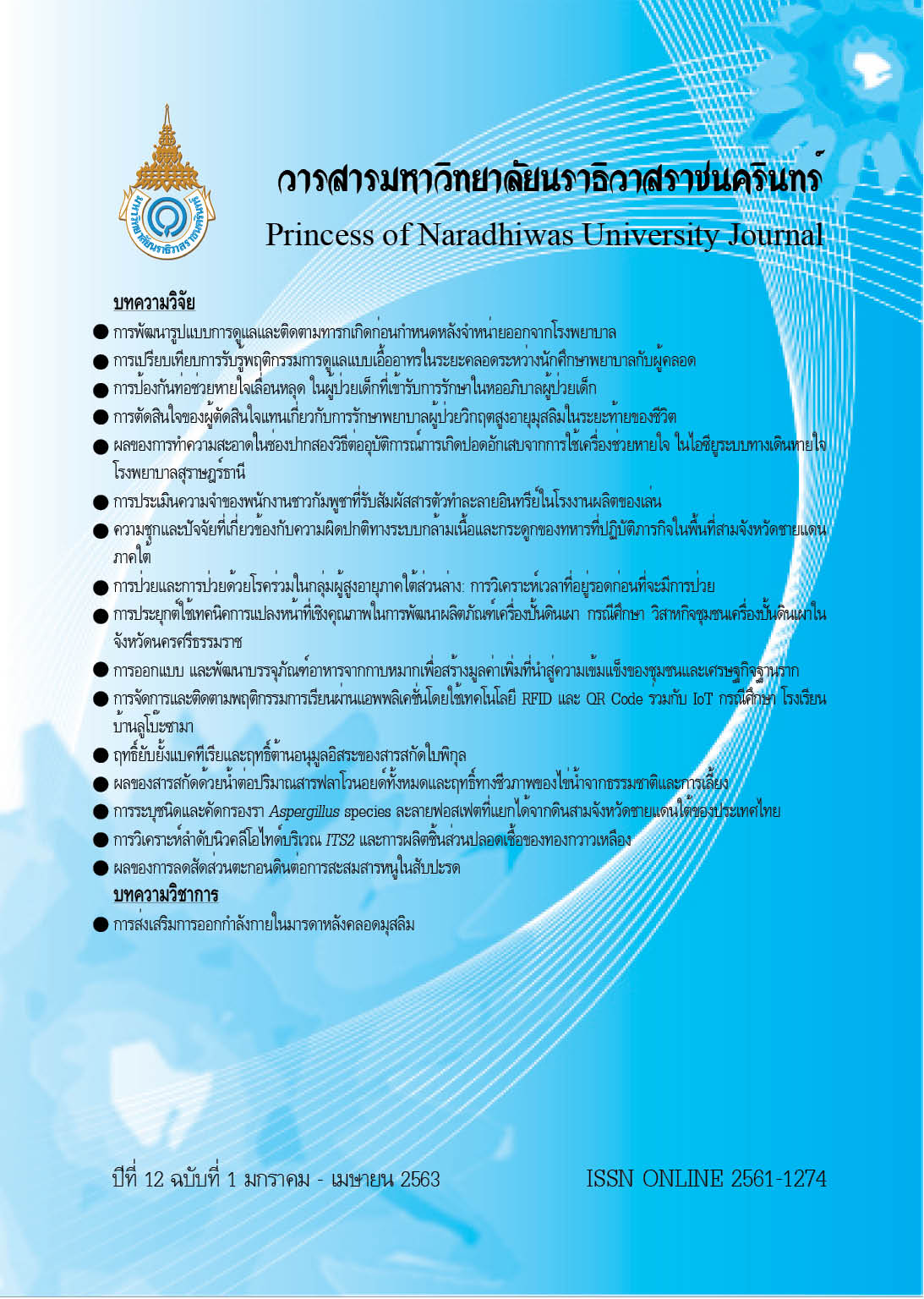Effect of Reservoir Sediment Ratio in Soil Media on Arsenic Accumulation in Pineapple (Ananas comosus [L.] Merr.)
Keywords:
Arsenic accumulation, Dilution technique, PineappleAbstract
The objective of this research is to solve the contamination of Arsenic in the sediment of the Phu Sawan reservoir in Kaeng Krachan District of Petchaburi Province as it found that there is a lot of sediment in the reservoir and contains arsenic for 26.2 mg/kg, which was exceeded the guideline limit. Therefore, the dredging for agricultural benefit by soil dilution technique is interesting. This article (1) studied the suitable
proportion of soil dilution technique towards the growth of pineapple, and (2) examined the accumulation
of arsenic in parts of the plant, designed by Completely Randomized Design (CRD) with 4 treatments, 1 normal soil + 3 ratios by weight (Sediment: Soil); 0:1, 1:10, 1:5 and 1:1 and 3 replications. The experimental
samples were harvested at 3 growth stages: before flowering stage, flowering stage and harvesting stage.
As the result, it was found that the treatment (Sediment : soil = 1:10) provides the best result while the
treatment (Sediment : soil = 1:1) gives the low rate of growth. As a result included 3 stages, it was found
the arsenic accumulation at the highest rate at the root. The treatment (Sediment : soil = 1:10) has the low
arsenic accumulation in roots and leaves which is not different from the normal soil. It was found that the
Arsenic accumulation in pineapple fruits of the treatment (Sediment : soil = 1:10) has the lowest value or
0.0134 mg/kg.
References
Ahmad,M.,Lee,S.S.,Yang,J.E.,Ro,H.M.,Lee,Y.H.,&Ok,Y.S.(2012).Effectsofsoildilutionandamendments (mussel shell, cow bone, and biochar) on Pb availability and phytotoxicity in military shooting range soil. Ecotoxicology and Environmental Safety, 79, 225-231.
Bhuthorndharaj, S. (1994). Arsenic Accumulation in Various Tissue of Some Plants. M.S. Thesis, Kasetsart University. (in Thai)
Chapman, H.D. (1965). Cation exchange capacity. In: C.A. Black, (Ed.), Method of Soil Analysis part 2 Agronomy No. 9. Wisconsin: American Society of Agronomy.
Food and Drug Administration. (2004). Food Safety Programme: Report from Food and Drug Administration.
Bangkok: Ministry of Public Health. (in Thai)
Gee, GW., & Bauder, J.W. (1986). Particle-sized analysis. In: A. Klute, (Ed.), Methods of Soil Analysis Part 1 Physical and Mineralogical Methods. American Society of Agronomy. Madison: Soil Science Society of America.
Hseu, Z.Y., Su, S.W., Lai, H.Y., Guo, H.Y., Chen, T.C., & Chen, Z.S. (2010). Remediation techniques and heavy metal uptake by different rice varieties in metal - contaminated soils of Taiwan: New aspects for food safety regulation and sustainable agriculture. Soil Science and Plant Nutrition,56(1), 31-52.
Hutton M. 1987. Human health concerns of lead, mercury, cadmium and arsenic. In: T.C. Hutchinson, K.M. Meema, (Eds.), Lead, Mercury, Cadmium and Arsenic in the Environment. New York: John Wiley and Sons.
Kobkhangphlu, S., Chumpookam, J., & Chatbanyong, R., (2018). Effect of Calcium Oxide on Vegetative Growth of ‘Phuket’ Pineapple [Ananas comosus (L.) Merr.]. Thai Journal of Science and Technology, 7(6), 592-599.
Land Classification Division and FAO Project staff. (1973). Soil Interpretation Handbook for Thailand. Land Classification Division, Bangkok: Department of Land Development. (in Thai)
Land Development Department. (2011). Soil Group Map. Retrieved from http://eis.ldd.go.th/lddeis/SoilView.aspx.
Ministry of Natural Resources and Environment, Notification of the National Environment Committee, No. 25. (2004). Issued under the Enhancement and Conservation of the National Environmental Quality Act 1992. Standard for Soil Quality in Thailand. 20 October 2004. 170-181. (in Thai)
Nateewattana, J. (2014). Arsenic Phytoremidiation in Soil and Sediment: Machanism and Management. Khon Kaen University Science Journal, 42(4), 730-747.
Panichsakpatana, S., Thongju, C., & Khaokaew, S. (2016). Soil Pollution. Bangkok: Kasetsart University. (in Thai)
Pickering, I.J., Prince, R.C., George, M.J., Smith, R.D., George, G.N., & Salt, D.E. (2000). Reduction and Coordination of Arsenic in Indian Mustard. Plant Physiology, 122, 1171-1177.
Schmöger, M.E.V., Oven, M., & Grill, E. (2000). Detoxification of Arsenic by Phytochelatins in Plants. Plant Physiology, 122, 793-801.
Smith, E., Naidu, R., & Alston, A.M. (2002). Chemistry of Arsenic in Soils: II. Effect of phosphorous, sodium and calcium on arsenic sorption. Journal of Environmental Quality, 31(2), 557-563.
Stazi, S,R., Mancinelli, R., Marabottini, R., Allevato, E., Radicetti, E., Campiglia, E., Marinari, S., (2018). Influence of Organic Management on As Bioavailability: Soil Quality and Tomato As Uptake.Chemosphere. 211, 352-359.
The King’s Royally Initiated Laem Phak Bia Environmental Research and Development Project. (2013). Final Report: Water quality management in Phu Sawan Watershed (Phase I and II). Bangkok: Kasetsart University. (in Thai)
United States Environment Protection Agency (USEPA). (1982). Test Methods for Evaluating Solid Waste (2nd ed.). Washington DC: Department of Commerce.
Walkley, A., & Black, C.A. (1934). An examination of the Degtjareff method for determining soil organic matter and a proposed modification of the chromic acid tritation method. Soil Science, 37, 29-38




